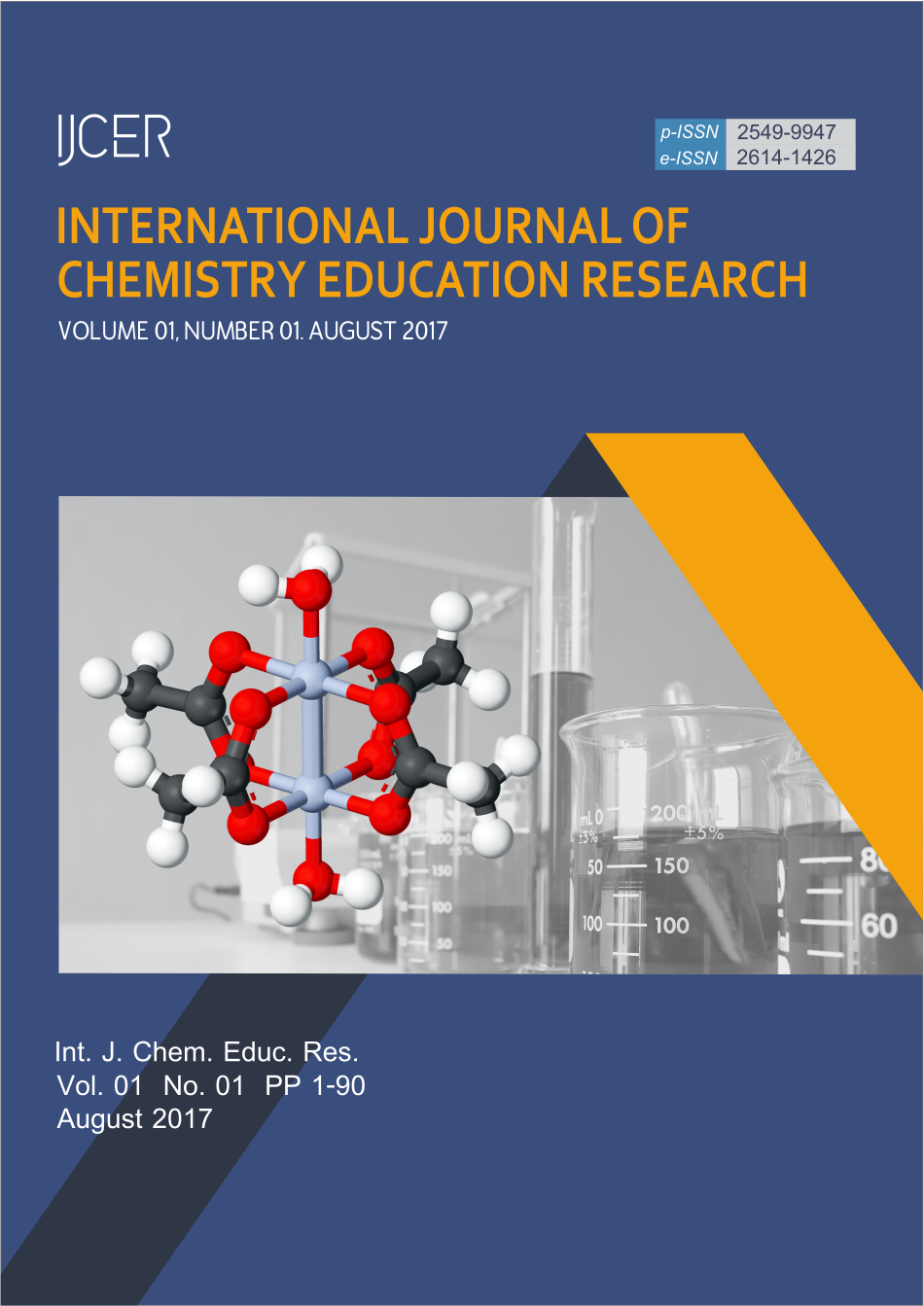Main Article Content
Abstract
ABSTRACT:There had been done a study of Visual Based Learning (VBL) method based on Short Duration Video for Instrumental Chemicals Subject in Chemistry Study Program of Mathematics and Natural Sciences Faculty (MNSF), Islamic University of Indonesia (Universitas Islam Indonesia—UII). VBL method is carried out by creating a short duration video about an instrument according to the syllabus of instrument 1 subject such as AAS, UV-Vis Spectrophotometer, FTIR, GC-MS, and CV. In order to determine the effect of VBL method using, an analysis of scores obtained between the experimental class and the control class is used. To determine the effect of VBL on psychomotor ability is done by observing directly when students do an experiment or practicum. The influence of VBL method application on student motivation was studied by using questionnaire. The results pointed out that the data of both samples (both classes) is homogeneous. T-test results: Two-Sample Assuming Equal Variances showed that there is a significant difference in the final scores mean between the experimental class and the control class. Based on the mean score it indicates that the VBL method is better while compared to the learning method without VBL. VBL method has a significant effect on students motivation and
psychomotor ability when it is viewed from observation of practicum and the score of practicum. The conclusion is that the VBL method is able to increase students' motivation and psychomotor ability in the Instrumental Chemistry subject.
Keywords: Learning, video, chemistry, instrumental
Received: 20 June 2017, Revised: 13 August 2017, Accepted: 1 September 2017
Article Details
Author retain copyright and grant the journal right of first publication with the simultaneously licenced under A Creative Commons Attribution (CC-By-SA) 4.0 License that allows others to share the work with an acknowledgment of the worsk's authorship and initial publication in this journal.
References
- Seng, 2009, W.C., Introduction to Problem-Based Learning (PBL), National Training Lab., Bethel, Maine, USA.
- I. A. Richard, “Learning to Teach Sixth Edition†(Mc Grow Hill, United State, 2004).
- S. N. Elliot, S. M. Sheridan and F. M. Gresham, JSP, 27, 2, 197 – 222, 2011.
- T. David, L. Patel, K. Burdett and P. Rangachari, Med. Educ, 34, 4, 322 – 323, 2000.
- H. S. Barrows, “Excerpt from Problem-Based Learning Applied to Medical Educationâ€, (The Royal Society of Medicine Press Limited, London, 2000).
- A. Myers, J. Opt. Ed, 15, 4, 105-110, 1990.
- B. Henriksen and A. Neppl, Curr. Pharm. Teach. Learn, 6, 3, 380 – 385, 2014.
- H. T. Hou, Comput. Human. Behav, 48, 424 – 435, 2015.
- P. L. Lei, C. T. Sun, S. S. J. Lin and T. K. Huang, Comput. Education, 87, 326-339, 2015.
- K. Saiman, S. Sinnatamby, L. M. Mustafa, N. Alias and S. Siraj, Procedia - Social and Behavioral Sciences, 103, 459-466, 2013.
- R. Peredo, A. Canales, A. Menchaca and I. Peredo, Expert. Syst. Appl, 38, 12, 14690-14702, 2011 .
- Z. Merchant, E. T. Goetz, L. Cifuentes, W. K. Kennicutt and T. J. Davis, T.J., 2014, Comput. Education, 70, 29-40, 2014.
- J. Kuhn and A. Müller, Perspectives in Science, 2, 1 –4, 5-21 , 2014.
- R. Kay and I. Kletskin, Comput. Education, 59, 2, 619-627, 2012.
- B. Marsh, N. Mitchell and P. Adamczyk, Comput. Education, 54, 3, 742-748, 2010.
References
Seng, 2009, W.C., Introduction to Problem-Based Learning (PBL), National Training Lab., Bethel, Maine, USA.
I. A. Richard, “Learning to Teach Sixth Edition†(Mc Grow Hill, United State, 2004).
S. N. Elliot, S. M. Sheridan and F. M. Gresham, JSP, 27, 2, 197 – 222, 2011.
T. David, L. Patel, K. Burdett and P. Rangachari, Med. Educ, 34, 4, 322 – 323, 2000.
H. S. Barrows, “Excerpt from Problem-Based Learning Applied to Medical Educationâ€, (The Royal Society of Medicine Press Limited, London, 2000).
A. Myers, J. Opt. Ed, 15, 4, 105-110, 1990.
B. Henriksen and A. Neppl, Curr. Pharm. Teach. Learn, 6, 3, 380 – 385, 2014.
H. T. Hou, Comput. Human. Behav, 48, 424 – 435, 2015.
P. L. Lei, C. T. Sun, S. S. J. Lin and T. K. Huang, Comput. Education, 87, 326-339, 2015.
K. Saiman, S. Sinnatamby, L. M. Mustafa, N. Alias and S. Siraj, Procedia - Social and Behavioral Sciences, 103, 459-466, 2013.
R. Peredo, A. Canales, A. Menchaca and I. Peredo, Expert. Syst. Appl, 38, 12, 14690-14702, 2011 .
Z. Merchant, E. T. Goetz, L. Cifuentes, W. K. Kennicutt and T. J. Davis, T.J., 2014, Comput. Education, 70, 29-40, 2014.
J. Kuhn and A. Müller, Perspectives in Science, 2, 1 –4, 5-21 , 2014.
R. Kay and I. Kletskin, Comput. Education, 59, 2, 619-627, 2012.
B. Marsh, N. Mitchell and P. Adamczyk, Comput. Education, 54, 3, 742-748, 2010.




